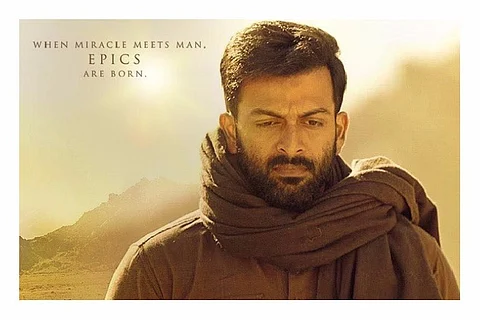

*Some spoilers ahead
A few minutes into Tiyaan, I was impressed with the film's courage to take on Hindutva goons. Set in the Hindi heartland where might is increasingly becoming right as long as you swear by Hindu majoritarianism, Tiyaan at first glance, is a brave attempt to speak out against the violence and bigotry perpetuated in the name of religion.
Written by Murali Gopy (who also plays the role of Mahashay Bhagwan in the film) and directed by Jiyen Krishnkumar, the first half of the film delves into the frightening Hindu and Hindi rashtra vision that is steadily acquiring acceptance in the mainstream.
We're shown a Muslim shopkeeper beaten up and asked to vacate the premises because the ashram belonging to Mahashay Bhagwan, a powerful godman needs his land. A Malayali Nair (Suraj Venjaramoodu) names his shop 'Nayyar' in the hope that the Punjabi upper caste name will protect him from the goonda raj. The same Nair, however, brings up the Manusmriti to advise his Brahmin friend not to allow the Dalits in the village from using his well - and is berated for it.
Cow politics finds its place, too. While the ashram's musclemen revere the cow as mother, the men who run its finances relish imported beef behind the scenes. The Naxals get a nod as the folks who stand up for the marginalized.
However, Tiyaan quickly dissolves into a mess, pitting "righteous" Hinduism (and Islam) against Hindutva while glorifying Brahminism. The "saviour" Brahmin here is Pattabiraman Giri (Indrajith) who is from the giri sampradaya established by Adi Shankaracharya.

While Pattabiraman pats the head of a Dalit child lovingly and teaches him the correct way to pray to Hanuman, he is happy to make declarations like, "You can only step into my threshold after committing the sin of killing a Brahmin!" when the ashram henchmen threaten him. He pulls out his "sacred" thread to warn folks that they dare not touch his ancient powers aka privilege.
And in one of the film's most offensive examples of glorifying Brahminism, the same Dalit child bows to the mighty Brahmin when the Hindutva goons try to instigate him to chuck a stone at the latter. This, even as the goons point out that it is the Dalits who've suffered the most because of the Brahmins.
The makers of Tiyaan don't seem to have engaged with caste politics at all, beyond declaring that "Sanatana dharma" treats everyone equally. Here's some news, there is no such thing as a "benign" or "kind" caste system. Caste, by its very existence, is violent.
Pattabiraman graciously allowing the grateful Dalits to draw water from his well does not mitigate the cold fact that he is sitting on a pile of privilege obtained through centuries of oppression and what's more, he actually takes immense pride in that very caste identity and its symbols.
To add insult to injury, the Dalits in the film don't speak at all - the patronising representation of the young boy's mother, her face full of admiration and gratitude towards the great Brahmin man, made me squirm in my seat more times than I care to remember.
Even a simple Internet research would have been sufficient for the filmmakers to understand why these portrayals are deeply offensive. However, the film is so smug in its belief that it's on the path of justice that it doesn't seem to have occurred to anyone to actually engage with the Dalit voice at all.
.png_image_784_410.jpg?w=640&auto=format%2Ccompress)
Prithviraj enters the narrative as a "wise" Muslim man spouting inanities about "true" spiritualism from Islam. He plays the role of Aslan Mohammad who is supposedly blessed by Allah for...well, there's no good reason, really, other than a flimsy storyline about a mythical link between Pattabiraman and him.
Murali Gopy's story is eager to drive home the point that the two major religions which are at loggerheads in the country preach the same "good" things and that all the "good" people must stand up against the evil propagated by fake godmen like the ashram's Bhagwan.
However, this "enlightening" message is simplistically constructed with a good deal of pretentiousness and mumbo jumbo. The women and children only exist to be either raped, beaten, or killed - they are the lambs that the powerful men sacrifice in their quest for "higher" truths. Tell me again, why is this a "righteous" battle?
A sizeable portion of the film has dialogues in Hindi and it can be a struggle for viewers who don't understand the language to read the subtitles and focus on what's happening on screen simultaneously. Gopi Sunder's music works for the first half but becomes too loud as the film turns into a train-wreck. The cinematography deserves a mention, with the camera trying to give the viewer the sense of attaining a higher spiritual plane by exposing one to vast landscapes and the smallness of the self within it. The film's lead cast have a good presence, especially Indrajit, Prithviraj and Murali Gopy, but are let down by the poor writing.
At one point, a mother who is a Mahashay devotee ends up with a dead child because she thinks the godman is enough to cure her child of her illness. Our hero Pattabiraman, with the help of Aslan, brings her back to life and this miracle is enough for the mother and everyone else in the village to become Pattabiraman's followers.
The message I walked away with is - religion is indeed a wonderful opium as long as you find the right dealer.